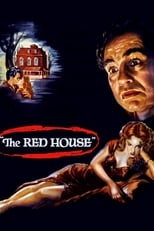Steve
Oct 4, 2016
7.5/10
The Red House is one of the first rural noirs.
Some casual noir fans may be surprised that so many noir stories take place outside the rain-soaked dark alleys of the city. "Rural noir" has been happening since the beginning of the noir movement with Albert Dekker crawling out of a abandoned mansion in the swamp in Among the Living. It continued on with some truly great films like the atmospheric greats Moonrise and On Dangerous Ground (that one at least starts in the mean streets of the city).
And as Gary notes at NoirWorthWatching, Rural noir is as big as it ever was.
The Red House is perhaps the most well known of the bunch due to it being in the public domain. And --like Too Late for Tears -- was available in nearly every bargain film noir DVD collections released. Every collection had the same copy. It looks like the movie was fished out of Edward G. Robinson's sunken car after the movie wrapped. (As I mention below, that's not necessarily a bad thing.)
This year, along with many other noir, it was re-released on DVD in great shape.
Unfortunately, this isn't the best Rural noir or Edward G. Robinson film noir. But it is worth a look again thanks to the films strangeness.
First, the teenagers in the film. All the actors seem to be the right age except for the second billed Lon McCallister. His crow's feet and receding hair line made me think he should probably consider the advantages of a reverse mortgage when he starts blabbing on about buying a little house with Julie London. His scenes with his single mother reach David-Lynch levels of creepiness. Like when he kisses his mother full on the lips before insisting she have fun on her honeymoon. Writers try to explain his age by saying that farm boys went to high school years longer due to having to take so much time off to take care of the family farms.
London was one of the inspirations for Jessica Rabbit (along with Rita Hayworth's Gilda and Veronica Lake's peek-a-boo hair). You'll quickly figure out what parts when London strips down for a swim with Lon. She literally steals every scene she's in. London would quickly change tracks in her career focusing on her lounge act, with occasional acting roles. The rarely-seen The 3rd Voice is one worth seeking out. Being the body for Jessica Rabbit and the ex-wife of Jack Webb is enough to make her film noir royalty. I'm old enough to remember her as Dixie on Emergency! and I could never understand why men where jumping through hoops over the older cigarette-aged nurse on the show. Trivia: London got the Emergency! gig so producer Webb wouldn't have to pay her any more alimony.
Allene Roberts plays the adopted daughter of Robinson and Judith Anderson. She has one of those breathy teenage girl voices that EVERY girl had in movies around this time. It's annoying. But she does a very good job as a troubled coming-of-age girl.
For anyone that thinks the 40s were a more innocent time should check out The Red House. All the girls are sexualized, with Roberts walking around in tight sweaters an bullet bras -- and she's the good girl. Not to mention 20-something Rory Calhoun picking up high-school aged London. (Calhoun is unfortunately known today as an odd Simpsons reference)
As for the adults, Robinson and Judith Anderson first appear to be husband and wife. In fact they are brother and sister -- his sister giving up her life for her brother. Their daughter turns out not to be their daughter. Without giving away too much, it's clever how the film makers make us assume their relationships when really it's much darker.
Robinson's best film noir roles were all right around this time. The Stranger, Scarlet Street, Woman in the Window, Key Largo and Double Indemnity all were released within 5 years of this one. All are superior to this. I will say he does his bug-eyed crazy acting that reminds me of his gangster films like Little Caesar.
Anderson isn't given much to do. Which is a shame. She does have a moment when she demands to know if teenage Roberts was touched by her brother.
Moments like that are creepy but probably not in the way the film makers intended. The direction (by Delmer Daves -- director of Dark Passage also in '47) is surprisingly flat and the music -- especially the romantic, innocent music over the teenagers scenes-- is so generic that its clear no thought was put into the soundtrack.
The film reminds me a bit of Blue Velvet-- where everyday life is stripped away to reveal horrible secrets and violence. But it's nowhere near in the same league. Worth a watch though and the ending is satisfying.
one final note: Advantages of a bad print. I will say that I enjoyed this movie more watching a bad print of it. It gave it a more chilling quality. Cleaned up beautifully on DVD is great, but the film actually loses some of it's mystery. The same could be said for other movies I watched for years like Key Largo and Foreign Correspondent. The copies I first saw appeared like the film was recovered from the wreckage of the movies actions, left out in the rain, put through a broadcast filmchain and transferred to video. www.noiroftheweek.com
